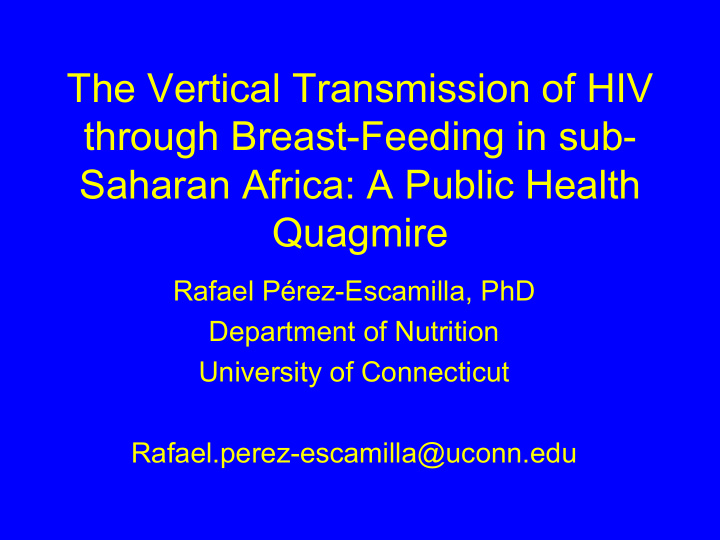



The Vertical Transmission of HIV through Breast-Feeding in sub- Saharan Africa: A Public Health Quagmire Rafael Pérez-Escamilla, PhD Department of Nutrition University of Connecticut Rafael.perez-escamilla@uconn.edu
Breastfeeding Advantages nutritional value fertility return immunologic postpartum hemorrage protection breast cancer gastrointestinal infections respiratory infections otitis media infantile diabetes intellectual development
Lecture Outline • HIV/AIDS epidemiology • Vertical transmission (MTCT) of HIV – Scientific evidence – Public health intervention options • RIING project – Grant structure and goals – Longitudinal study – Capacity building • Human resources
• In 2003: – 5 million children and adults became infected with HIV – 3 million people died of AIDS Source: UNAIDS (2004)
Almost 38 Million People are Living with HIV/AIDS Sub-Saharan Africa 25 South & Southeast Asia 20 Latin America millions of people Eastern Europe & 15 Central Asia North America East Asia 10 Western Europe 5 N. Africa & Mid East Caribbean 0 WHO Region Oceania Source: UNAIDS (2004)
Adult HIV/AIDSInfection Rate Sub-Saharan Africa 8 South & Southeast Asia 7 Latin America 6 Eastern Europe & 5 Central Asia % North America 4 3 East Asia 2 Western Europe 1 N. Africa & Mid East 0 Caribbean WHO Region Oceania Source: UNAIDS (2004)
Women & HIV • By December 2003, women accounted for nearly 50% of all people living with HIV. • In sub-Saharan Africa, women accounted for 57% of HIV cases.
HIV Transmission to Child Through BF: Scientific Evidence • In middle 80’s, viable HIV virus isolated in breast milk, yet compound(s) in human milk destroy HIV virus in-vitro (Newburg & Yolken, 1992; Van de Perre, 1993) • Seroconversion of breastfed children born HIV- – Women infected post-partum with HIV – Seroconversion after being breastfed by an HIV+ wet nurse • Experimental study in Nairobi, Kenya showing a twofold increase in transmission among BFed vs. Formula Fed children
Vertical HIV Transmission from Mother to Child Over one million children are infected now with HIV and there are about 1,500 new cases per day, mostly in developing countries (Sub Saharan Africa) Overwhelming majority contract HIV via their infected mothers • In-Utero • At birth • Breast-feeding
Risk of MTCT of HIV in Developing Countries ( LINKAGES, 2001) Of 100 women in community with 25% HIV prevalence at delivery, 100 100 25 women are infected with HIV. 90 80 Of the 25 women who are infected, 70 9 pass the virus to their infants. 60 Of the 9 mothers who transmit the virus, 50 40 4 pass the virus through breastfeeding. 25 30 20 9 10 4 0
HIV Transmission to Child Through Breast-feeding • 30 to 40% of HIV+ children infected through breast milk • possible routes: milk, abscessed or cracked nipples
Prevention of Vertical Transmission through Breast-feeding: Voluntary Counseling and Testing • Replacement infant feeding? • Milk pasteurization? • Antiretroviral therapies? (Connor et al. 1994; CDC 1998) • Maternal vitamin A supplementation? (Nduati et al., 1995)
Replacement Feeding • No testing and little contact with health care systems in countries where breast-feeding and HIV are highly prevalent among women. • Alternative infant feeding practices (e.g. infant formula) safe in areas with poor sanitation? • Discrimination against HIV+ women identified by community because they are not breast-feeding. • Does EBF reduces the risk of transmission? (Coustodis 1999) • Cumulative risk associated with prolonged EBF?
Milk Pasteurization? • Wood • Fuel • Milk extraction system • Thermometer • Compliance • Implications for milk banks?
Antiretroviral Therapies: AZT Zidovudine (AZT) • long term: starts in the 14th week of pregnancy, continues during delivery (IV) and the neonate is treated for six weeks following delivery. Reduces risk of vertical transmission among non Bfed babies by 70% at a cost of $1000 per person • short term: starts in the 36th week of pregnancy, and continues during delivery (IV). Reduces risk of vertical transmission among non Bfed babies by 50% at a cost of $50 per person
Antiretroviral Therapies: Nevirapine • Nevirapine • Uganda study found that Nevirapine can decrease substantially the risk of transmission through breast- feeding by providing one dosage to the mom during delivery and one dosage to the newborn within the first 72 hours of life. • Cost: $4 per person.
Vitamin A • Three randomized trials have failed to show any benefit in terms of decreased vertical transmission of HIV as a result of vitamin A supplementation of women at risk of deficiency of this vitamin • Tanzania • South Africa • Malawi
Prevention of Vertical Transmission through Breast-feeding: Voluntary Counseling and Testing • Replacement infant feeding????? • Milk pasteurization????? • Antiretroviral therapies? (Connor et al. 1994; CDC 1998) • Maternal vitamin A supplementation Does not work
Key Unanswered Questions • What are women told during VCT? • Do women change their caregiving plans? – Feeding – Cleaning – Amount of contact with infant • Are HIV- babies at a disadvantage if they are born to an HIV+ mom? – Does social support modifies this relationship? • What strategies used by HIV+ women lead to better child growth and development outcomes? – Exclusive breastfeeding – Surrogate caregiver
Research to Improve Infant Nutrition and Growth (NIH Funded) • Iowa State University (PI: Grace Marquis) • University of Ghana (PI: Anna Lartey) • University of Connecticut (PI: Rafael Pérez-Escamilla) Social scientist consultants Daniel Sellen (U. Toronto) Bob Mazur (ISU)
Prenatal VCT-1 NO YES HIV test HIV- HIV+ (N=150) (N=150) Prenatal VCT-2 (N=150) Prenatal Interview (3 rd trimester) Birth Interview One year of follow-ups
Contact Points • Prenatal clinic • Prenatal home • Birth: hospital or home • Home follow ups
Follow-up Surveillance & Interviews • Morbidity and child feeding surveillance – Twice weekly • Maternal and child anthropometry – Monthly • Child motor development – Monthly • Stigma, depression, social support, household economics, other…. – Quarterly • 24 hour home observation – Breast milk production, maternal-infant interactions, time allocation – N=50 per group @ 1, 3 and 6 months
CAPACITY BUILDING
DOCTORAL/MASTERS FELLOWSHIPS
http://www.fcs.iastate.edu/fshn/riing/default.htm
GO BLACK STARS!
Recommend
More recommend